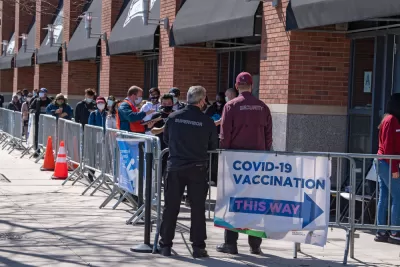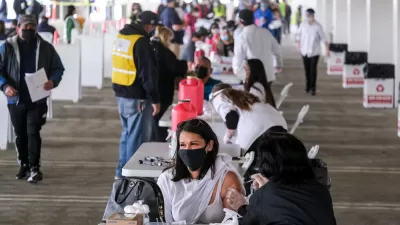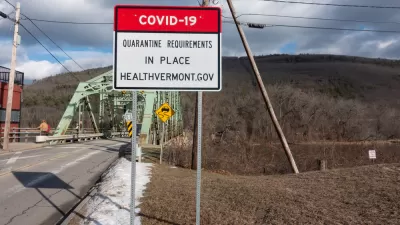The Centers for Disease Control and Prevention may be changing its thinking about how herd immunity fits in with the goal of controlling the coronavirus. At the same time, the waning immunity of vaccinated Americans has taken on more urgency.

“If you really want true herd immunity, where you get a blanket of protection over the country ... you want about 75 to 85 percent of the country to get vaccinated,” said Dr. Anthony Fauci, the nation’s leading infectious disease scientist, in an interview with a Vox on Dec. 15, 2020.
[Related post: "Pandemic Endgame: The Goalposts are Moving," December 30, 2020.]
A day earlier, Sandra Lindsay, a critical care nurse at Long Island Jewish Medical Center in New York, became the first American inoculated with a COVID-19 vaccine. “I believe this is the weapon that will end the war,” said Gov. Andrew Cuomo, reported The Washington Post on the historic day.
Since then, over 195 million Americans, almost 59% of the population, have become fully vaccinated against the novel coronavirus disease that has killed more than 764,000 Americans and well over 5 million people.
Herd immunity out—waning immunity in
Now we learn from Karen Kaplan, a science and medicine editor at the Los Angeles Times who writes their Coronavirus Today newsletter, and Melissa Healy, a D.C.-based health and science reporter also with the Times, that the herd immunity goalposts are moving again. In fact, they appear to have been removed from the field entirely.
Kaplan writes that Healy was covering the Nov. 2 meeting [pdf] of the Centers for Disease Control and Prevention's (CDC) Advisory Committee on Immunization Practices where they voted unanimously to recommend the COVID-19 vaccine manufactured by Pfizer and its German partner, BioNTech, for use in children aged 5-11 years old.
Dr. Oliver Brooks, a panel member and chief medical officer of Watts Healthcare in Los Angeles, asked CDC representatives to discuss how rolling out the vaccine to children of this age group "could bring the country closer to its herd-immunity goal." [Boldens by Kaplan].
At first, Brooks was met with an awkward silence. Then, Dr. Jefferson Jones, a medical officer on the CDC’s COVID-19 Epidemiology Task Force, spoke up.
“Thinking that we’ll be able to achieve some kind of threshold where there’ll be no more transmission of infections may not be possible,” Jones told the CDC panel. The widespread phenomenon of waning immunity — among people who survived coronavirus infections as well as those who’ve been vaccinated — has made the adoption of a clear herd-immunity goal “very complicated,” he added.
Protection from severe disease vs. transmission
The real value of the three 'first-generation' FDA-approved or authorized COVID-19 vaccines are their ability to prevent serious illness that results in hospitalization. Transmission, on the other hand, is more difficult to stop by vaccinations alone.
"Vaccines have been quite effective at preventing cases of COVID-19 that lead to severe illness and death, but none has proved reliable at blocking transmission of the virus, Jones noted," writes Healy in the source article on Nov. 12. "Recent evidence has also made clear that the immunity provided by vaccines can wane in a matter of months."
The result is that even if vaccination were universal, the coronavirus would probably continue to spread.
“We would discourage” thinking in terms of “a strict goal,” he said.
Impact on vaccinations?
That response did not sit well with Brooks, who noted that "Jones’ unexpected admission 'almost makes you less motivated to get more people vaccinated,'" adds Healy.
However, one of the main reasons that CDC changed its masking guidance on May 13 was to motivate people to get vaccinated, as NPR reported on May 20.
During a situation without historical precedent, the CDC's move is a gamble. The risk of loosening mask guidelines, of course, is that unvaccinated people will no longer feel compelled to wear masks at all.
Two months later, after almost all states had followed the CDC's guidance and ended universal masking, the Delta surge was causing cases to skyrocket in Missouri. While CDC corrected its masking guidance on July 27 after Provincetown, Mass. data showed that vaccinated people could transmit the virus, only six states today require universal indoor masking.
As for any beneficial impact on increasing the vaccination rate, 54 countries have higher percentages of their populations fully vaccinated, according to The New York Times tracker on Nov. 18.
Boosters for all
"With studies showing waning efficacy of initial covid vaccines, the federal government is moving closer to recommending boosters for all adults," states the Kaiser Health News Morning Briefing for Nov. 18. "It is behind several states that now allow them" (e.g., Colorado). The news that the FDA had approved boosters for all adults came just a day later, on November 19, according to an FDA press release.
Additional related posts:
- Boosters and Breakthroughs in Vermont, Oct. 4, 2021
- Pandemic Endgame: Redefining the Herd Immunity Goal, May 4, 2021
- Coronavirus Vaccine Could be Available by End of the Year, June 30, 2020
Hat tip to Dr. Monica Gandhi who referenced the source article in a Nov. 15 update to her opinion in the San Francisco Chronicle, "We need to start thinking differently about COVID outbreaks."
FULL STORY: CDC shifts pandemic goals away from reaching herd immunity

Planetizen Federal Action Tracker
A weekly monitor of how Trump’s orders and actions are impacting planners and planning in America.

Congressman Proposes Bill to Rename DC Metro “Trump Train”
The Make Autorail Great Again Act would withhold federal funding to the system until the Washington Metropolitan Area Transit Authority (WMATA), rebrands as the Washington Metropolitan Authority for Greater Access (WMAGA).

DARTSpace Platform Streamlines Dallas TOD Application Process
The Dallas transit agency hopes a shorter permitting timeline will boost transit-oriented development around rail stations.

DC, Columbus Bike Share Fleets Introduce Cargo Bikes
Shared mobility is ‘growing up,’ with rental options increasingly expanding to include e-bikes, scooters, and cargo bikes.

Five Key Transportation Funding Proposals in Trump’s Budget
The President’s proposed 2026 budget would keep spending roughly the same for transit and rail and eliminate over $5 billion in funding for EV charging infrastructure.

LA County Creating Action Plan to Tackle Extreme Heat
Los Angeles County is creating a Heat Action Plan to help communities stay safe during extreme heat, with steps like adding more shade, improving buildings, and supporting the neighborhoods most at risk.
Urban Design for Planners 1: Software Tools
This six-course series explores essential urban design concepts using open source software and equips planners with the tools they need to participate fully in the urban design process.
Planning for Universal Design
Learn the tools for implementing Universal Design in planning regulations.
City of Charlotte
Municipality of Princeton
Roanoke Valley-Alleghany Regional Commission
City of Camden Redevelopment Agency
City of Astoria
Transportation Research & Education Center (TREC) at Portland State University
US High Speed Rail Association
City of Camden Redevelopment Agency
Municipality of Princeton (NJ)





























